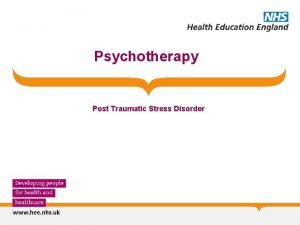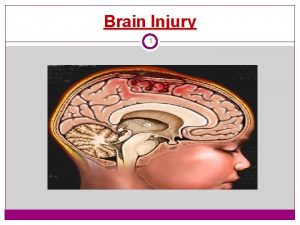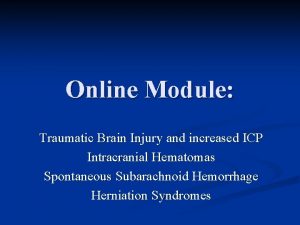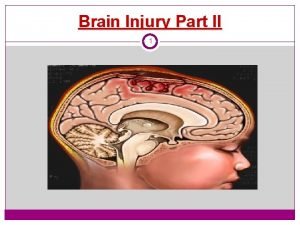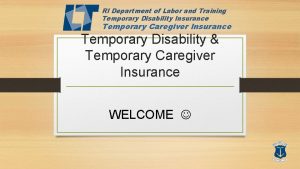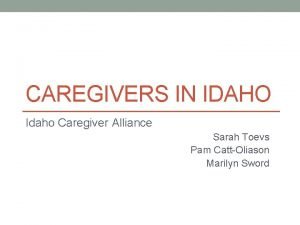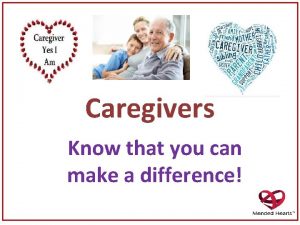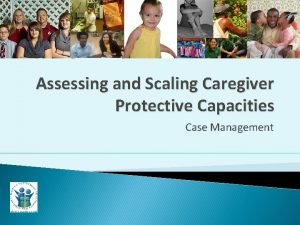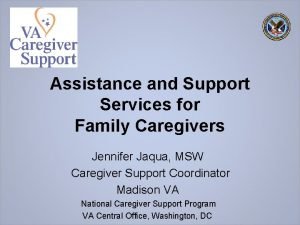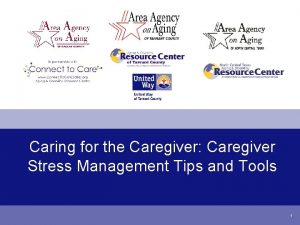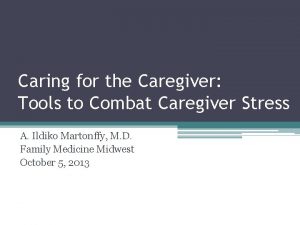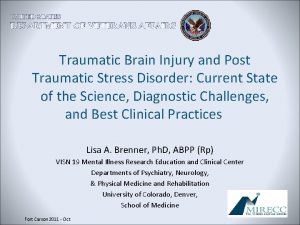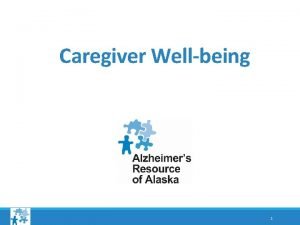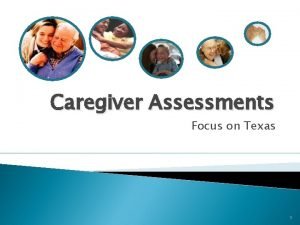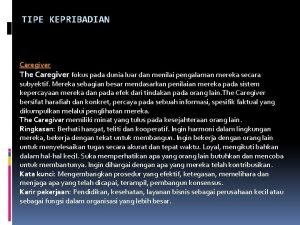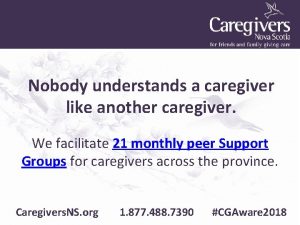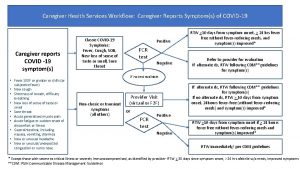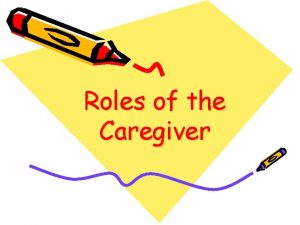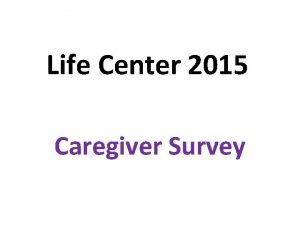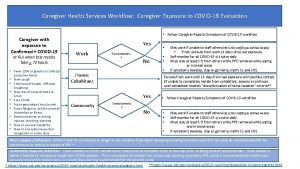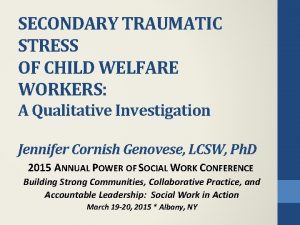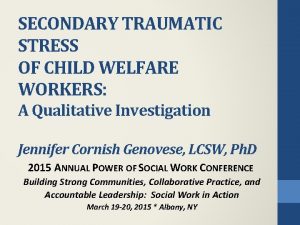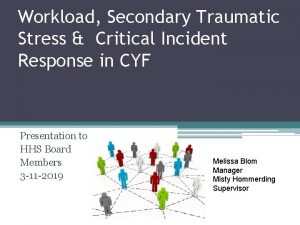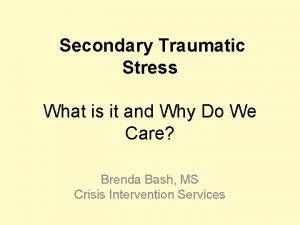Secondary Traumatic Stress Caring for the Caregiver Mary






























- Slides: 30

Secondary Traumatic Stress: Caring for the Caregiver Mary Mueller, LMSW Michigan Department of Health and Human Services

Objectives Define Secondary Traumatic Stress, Its Causes and Impacts Identify Self-Care Strategies Identify Organizational Strategies

Why Does This Matter? Self = Most important tool STS = Occupational Hazard Self Care = Personal Protective Equipment Increases ability to care for others effectively

Secondary Traumatic Stress The emotional duress that results when an individual hears about the firsthand trauma experiences of another. Its symptoms mimic those of post-traumatic stress disorder (PTSD). National Child Trauma Stress Network, http: //www. nctsn. org/resources/topics/secondary-traumatic-stress

Related Terms Compassion fatigue, less stigmatizing way to describe secondary traumatic stress Vicarious trauma , Cognitive changes that occur after cumulative exposure to another person’s traumatic experiences. Burnout, Emotional exhaustion, depersonalization, & a reduced feeling of accomplishment; general occupational stress. Compassion satisfaction, Positive feelings derived from competent performance as a trauma professional.

Who Is At Risk? Helping professionals Highly empathic (Women) Prior trauma experiences (also more compassion) Frequent exposure Socially or organizationally isolated Inadequate training

Protective Factors Knowledge about STS, risk factors & self-care strategies Longer duration of professional experience Use of evidence-based practices Supportive work environment

Three Levels of Care Personal Interpersonal Organizational Warning Signs Self-Assessment Finding Time

Personal: Warning Signs Hypervigilance Sleeplessness Hopelessness Fear Inability to embrace complexity Chronic exhaustion Inability to listen, avoidance of clients Minimizing Anger and cynicism Physical ailments Guilt

Personal: Self Assessment Tools Professional Quality of Life (Pro. QOL) Compassion Fatigue Self-Test Self-Care Assessment Checklist (What About You? ) Provider Resilience App

Provider Resilience APP, http: //t 2 health. dcoe. mil/apps/provider-resilience

Personal: Finding the Time. If You Have… 2 Minutes 10 Minutes Breathe Write in a journal Daydream Tidy your work area Doodle Dance Spend time with your pet Read a magazine 5 Minutes 30 Minutes Listen to music Get a massage Chat with a co-worker Spend time in nature Step outside for fresh air Go shopping Enjoy a snack; make a cup of… Practice yoga

Available at Pro. QOL. org

Interpersonal: Warning Signs Increased conflict Negative feelings when others reach out to you Can’t manage your relationships and work Losing interest in family rituals, routines & social activities Feeling helpless around the house Avoiding calls from friends or invitations Feeling disconnected, detached, or trapped Withdrawing and not seeking connection with others

Interpersonal: Self Assessment Relationship Pie Circle of Support Exchange Participation Friendship Intimacy

Interpersonal: Finding The Time. If You Have… 2 Minutes Leave a message to tell someone you’re thinking of them Let someone know you need to talk with them later Leave a note on the fridge that says “I love you” 5 Minutes Mail a card or e-greeting Send someone a list of dates for getting together Look at pictures of family/friends 10 Minutes Have breakfast with family/friend Research a group you may want to join Talk to someone about a problem/frustration 30 Minutes Read/play a game with a child Go for a walk with a friend Cook/eat with family/friend Write a letter to someone

Organizational: Warning Signs High rates of turnover, absences, tardiness Poor communication between individuals/departments Increased interpersonal conflict Missed deadlines Incomplete/poor quality work Increased customer complaints Negative atmosphere/low morale Less motivation/energy Lack of psychological safety

Organizational: Self-Assessment Tools Organization’s Stress Temperature Motivation vs Frustration Organizational Self Care Checklist

Take Your Organization’s Stress Temperature Describe how the organization looks when: Overwhelmed overwhelmed by stress Very stressful very busy, stressful & beginning to feel overwhelming More stressful beginning to get busier and more stressful calm and running smoothly Calm

Motivation vs Frustration When… Overwhelmed Very Busy & Stressful Busier & More Stressful Calm & Running Smoothly What is helpful What is NOT helpful

Organizational: Finding the Time – If You Have… 2 Minutes 10 Minutes Smile Clean up your workspace Make coffee Plan a celebration Thank someone Discuss a training opportunity with you supervisor Sign up for a training opportunity 5 Minutes Respond to an email Talk with someone you don’t usually work with Schedule a team meeting Straighten up a common area 30 Minutes Have lunch with colleagues Talk about burn out at a staff meeting Have a “walking meeting” outside Do “A Day in the Life” activity at staff meeting

A FEW MORE THINGS …

Trauma Stewardship Creating Space for Inquiry Engaging with our lives outside of work Gratitude Finding Balance Adapted from: Trauma Stewardship: An Everyday Guide to Caring for Self While Caring for Others, L. van Dernoot Lipsky Daily Centering Practice Building Compassion & Community Why am I doing what I’m doing? Is trauma mastery a factor? Is this working for me? Choosing Our Focus Where am I putting my focus? What is my Plan B? Creating a micro culture. Practicing compassion for myself and others

Caregiver’s Bill of Rights (Compassion Fatigue Awareness Project) To be respected for the work I choose to do To take time off to re-energize myself To take pride in my work and know that I am making a difference To socialize, maintain my interests, & sustain a balanced lifestyle To garner appreciation and validation for the care I give others To my own feelings, including negative emotions such as anger, sadness, & frustration To receive adequate pay for my job as a professional caregiver To express my thoughts & feelings to appropriate people at appropriate times To discern my personal boundaries and have others respect my choices To seek assistance from others, if and when it is necessary To convey hope to those in my care To believe those in my care will prosper in mind, body & spirits as a result of my caregiving

Your Wheel of Life The eight sections in Your Wheel of Life represent Balance. Treating the center of the wheel as 0 and the outer edges as 10, rank your present level of satisfaction with each slice of your life by drawing a straight or curved line to create a new outer edge. The new perimeter represents the wheel of your life. If this were a real wheel, how bumpy would the ride be?


I will boost my balance by making the following changes in the Family & Friends slice of my life: I will boost my balance by making the following changes in the Money slice of my life: I will boost my balance by making the following changes in the Significant Other/Romance slice of my life: I will boost my balance by making the following changes in the Personal Growth slice of my life: I will boost my balance by making the following changes in the Fun & Recreation slice of my life: I will boost my balance by making the following changes in the Physical Environment slice of my life: I will boost my balance by making the following changes in the Health slice of my life: I will boost my balance by making the following changes in the Career slice of my life:

Start where you are Use what you have Do what you can

Resources Secondary Traumatic Stress: A Fact Sheet for Child-Serving Professionals; National Child Traumatic Stress Network, www. nctsn. org Trauma Stewardship: An Everyday Guide to Caring for Self While Caring for Others, L. van Dernoot Lipsky with C. Burk What About You? : A Workbook for Those Who Work with Others, K. Volk, K. Guarino, M. Grandin, R. Clervil, The National Center on Family Homelessness Your Wheel of Life, Institute for Leadership Fitness, www. instituteforleadership. com All My Life’s A Circle: Using the Tools, Circle, MAPS & PATHS, M. Falvey, M. Forest, J. Pearpoint, & R. Rosenberg, Inclusion Press Caregiver’s Bill of Rights, Compassion Fatigue Awareness Project, www. compassionfatigue. org Professional Quality of Life Scale (Pro. QOL), B. Hudnall Stramm, www. proqol. org Provider Resilience App, National Center for Telehealth & Technology, http: //t 2 health. dcoe. mil/apps/provider-resilience

Thank You For Your Time! Mary Mueller, LMSW Michigan Department of Health & Human Services 517 -373 -4190 muellerm 1@michigan. gov www. michigan. gov/traumatoxicstress
 Post traumatic stress disorder
Post traumatic stress disorder Cptsd
Cptsd Post traumatic stress disorder
Post traumatic stress disorder Jean watson theory
Jean watson theory Tbi long term servival after traumatic
Tbi long term servival after traumatic Traumatic insemination
Traumatic insemination Traumatic brain injury concept map
Traumatic brain injury concept map Post traumatic cervical dystonia
Post traumatic cervical dystonia Csf traumatic tap
Csf traumatic tap Edh
Edh Subdural hematoma concept map
Subdural hematoma concept map Hyponuria
Hyponuria Raccoon
Raccoon Traumatic overbite definition
Traumatic overbite definition Tdi ri
Tdi ri Idaho family caregiver conference
Idaho family caregiver conference Oklahoma uniform symbol omma
Oklahoma uniform symbol omma Caregiver anxiety
Caregiver anxiety Caregiver sos wellmed
Caregiver sos wellmed Arizona caregiver coalition
Arizona caregiver coalition Caregiver formale
Caregiver formale Caregiver protective capacities
Caregiver protective capacities Va caregiver support
Va caregiver support Caregiver prayer
Caregiver prayer Mary wollstonecraft mary a fiction
Mary wollstonecraft mary a fiction Engineering vs true stress strain curve
Engineering vs true stress strain curve Normal stress
Normal stress Chapter 10 stress responses and stress management
Chapter 10 stress responses and stress management Mandibular edentulous anatomy
Mandibular edentulous anatomy Smärtskolan kunskap för livet
Smärtskolan kunskap för livet Vad är referatmarkeringar
Vad är referatmarkeringar

